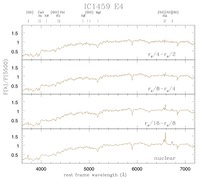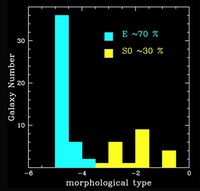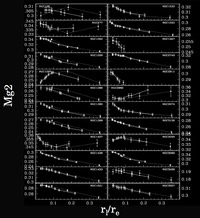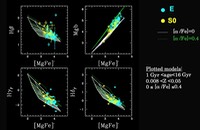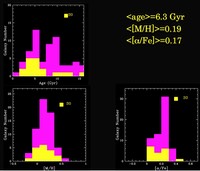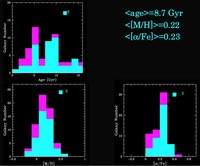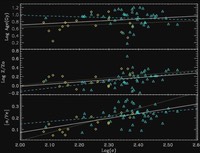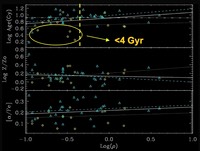Ellipticals are among the most luminous and massive galaxies in the Universe. Together with lenticular (S0) galaxies, composed of a bulge, a stellar disk and often a stellar bar component they form the vast category of early-type galaxies (ETGs). About 75% of ETGs show emission lines in their nuclei and often outside nuclei.
When the ionized region is imaged using narrow band filters centered at Ha +[NII 6583], it appears extended with morphologies ranging from regular, disk-like structures to filamentary structures (see e.g. Ulrich-Demoulin 1984; Buson et al. 1993; Zeilinger et al. 1996; Macchetto et al. 1996) of several kpc in radius. The gaseous disks appear to be generally misaligned with respect to the stellar body of the galaxy suggesting an external origin for most of the gaseous matter. This picture is also supported by the observations of decoupled kinematics of gas and stars in a significant fraction of early-type galaxies (Bertola et al. 1992)). Notwithstanding the large amount of studies, our current understanding of the origin and the nature of the ``warm'' ionized gas in elliptical galaxies is still rather uncertain.
The fact that the emission regions are always associated with dust absorption, even in the brightest X-ray systems, seems to exclude ``cooling flows'' as the origin of the ionized gas (see Goudfrooij 1998). The main ionization mechanism, which does not seem to be powered by star formation, however remains uncertain. Ionization mechanisms suggested range from photoionization by old hot stars -- post--AGB and/or AGB-Manque' type objects (Binette et al. 1994) -- or mechanical energy flux from electron conduction in hot, X-ray emitting gas (Voit 1991). Also ionization by a non-thermal central source is considered.
The present study aims to improve the understanding of the nature of the ionized gas in early-type galaxies by studying its physical conditions, the possible ionization mechanisms, relations with the other gas components of the ISM and the connection to the stellar population of the host galaxy. The adopted strategy is to investigate galaxy spectra of intermediate spectral resolution at different galactocentric distances and to attempt the modeling of their stellar populations to measure emission line properties. The study of stellar populations of early-type galaxies is of fundamental importance to the understanding of their evolution by the measurement of the evolution of the spectral energy distribution with time (see e.g. Buzzoni et al. 1992; Worthey 1992; Gonzalez 1993; Buzzoni et al. 1994;
Worthey et al. 1994; Leonardi & Rose 1996; Wothey & Ottaviani 1997; Trager et al. 1998; Longhetti et al. 1998; Vazdekis 1999; Longhetti et al. 1999; Longhetti et al. 2000; Trager et al. 2000; Kuntschner et al. 2000; Beuing et al. 2002; Kuntschner et al. 2002}; Thomas et al. 2003; Mehlert et al. 2003) . Investigating issues such as the evolution of stellar populations and the ISM, we will explore the complex, evolving ecosystem within ETGs and build a database of well studied galaxies to be used as a reference set for the study of intermediate and distant objects. Our target is to characterize the stellar populations, in particular those related to the extended emission region, in order to constrain hints about the galaxy formation/evolution history from the modeling of the complete (lines and continuum) spectrum characteristics. In this paper we present the sample, the observations and the data reduction and we discuss, through comparison with the literature, the database of line--strength indices we have measured. Forthcoming papers will analyze the emission region by tracing the properties as a function of the distance from the galaxy center.
Method
We obtained high S/N long--slit spectra covering the 370 - 725 nm wavelength range with a spectral resolution of ~7.6 A at 555 nm for 65 ETGs showing emission lines. Most of the galaxies are located in low density environments. For each object were extracted 7 luminosity--weighted apertures, corrected for the galaxy ellipticity, and 4 gradients. For each aperture and gradient we measured 25 line--strength indices: 21 of the set defined by the Lick-IDS ``standard'' system (Trager et al. 1998) and 4 introduced by Worthey & Ottaviani (1997). Line--strength indices have been transformed to the Lick-IDS system. Indices derived then include Hb, Mg2, Mgb, MgFe, Fe5270, Fe5335 commonly used in classic index-index diagrams.
Main Results
Ages, metallicities and [a/Fe] ratios of the underlying stellar populations have been derived for the apertures and the gradients through the comparison of the measured Lick indices with new Simple Stellar Population (SSP) models which account for the presence of a/Fe--enhancement.
The SSPs, which are based on the Padova stellar evolutionary tracks, cover a wide range of ages (108- 16x109 yr), metallicities (Z=0.0004, 0.004, 0.008, 0.02, 0.05) and [a/Fe] ratios (0-0.8). In order to derive the stellar population parameters, we make use of a suitable algorithm based on the probability density function that provides, together with the most probable solution in the (age, Z, [a/Fe]) space, also the solutions along the age-metallicity degeneracy that are within 1s error from the observed index values.
We derive a rather flat age distribution for our sample, with SSP-equivalent ages ranging from a few to 15 Gyrs. The age does not show any definite trend with central velocity dispersion sc, and from the fit we get an almost constant value of 6.3 Gyr for the whole sample, with Es galaxies being on average older than lenticulars.
On the contrary, a definite increasing trend of metallicity and [a/Fe] with sc is observed, testifying that the chemical enrichment was more efficient and the duration of the star formation shorter in more massive galaxies. These latter two relations do not depend on galaxy morphological type, differently from the age-sc relation, indicating that the galaxy gravitational potential is the main driver of the chemical enrichment process. We have seeked for possible correlations of age, metallicity and [a/Fe] with local galaxy density rxyz as well. While metallicity and a-enhancement do not show clear trend with galaxy density, age shows a remarkable behaviour: we find very young objects (from 1 Gyr to 4 Gyr, some of which with high sc) only in low density environments (LDE) (rxyz < 0.4), wheras none of the galaxies in the higher density environments (HDE) (40% of galaxies with a measured density) is younger than 5 Gyrs. The lack of environmental effect on the [a/Fe] ratio, suggests that young galaxies in LDE are more likely due to rejuvenation episodes rather than more prolonged star formations.
From the analysis of the stellar population gradients within galaxies, we derive negative metallicity gradients (metallicity decreases from the central regions outwards) of the order of D log Z/ D log (r/re) ~ -0.25, consistently with the literature values. However, galaxy located in LDE tend to have larger age and metallicity gradients, with younger and more metal rich nuclei with respect to HDE galaxies. Finally, by comparing the number of rejuvenated objects with the total number of galaxies in our sample, and by means of simple two-SSP component models, we estimate that the rejuvenation episodes (accretions, mergers, etc.) do not involve more than 25% of the total galaxy mass.
more details in
(1) Rampazzo R., Annibali F., Bressan A., Longhetti M., Padoan F., Zeilinger W.W.
Nearby early-tyep galaxies with ionized gas. I. Line-strength indices of the underlying stellar population
2005, A&A, 433, 497
(2) Annibali F., Bressan A., Rampazzo R., Zeilinger W.W.
Nearby early-tyep galaxies with ionized gas. II. Line-strength indices for 18 additional galaxies
2006, A&A, 445, 79
(3) Annibali F., Bressan A., Rampazzo R., Zeilinger W.W, Danese L.
Nearby early-tyep galaxies with ionized gas. III. Analysis of line-strength indices with new stellar population models
2007, A&A, 463, 455
